#the duality of elves
Explore tagged Tumblr posts
Text
chat we have new fandoms now
#trollhunters#garth nix#lego elves#ah the duality (triality???) of man#but yeah i need to reread the garth nix series because i only ever read sabriel and lirael#when i was about 9 methinks#is that healthy??? absolutely not#do i regret it?? no way in hell#raembles
9 notes
·
View notes
Text
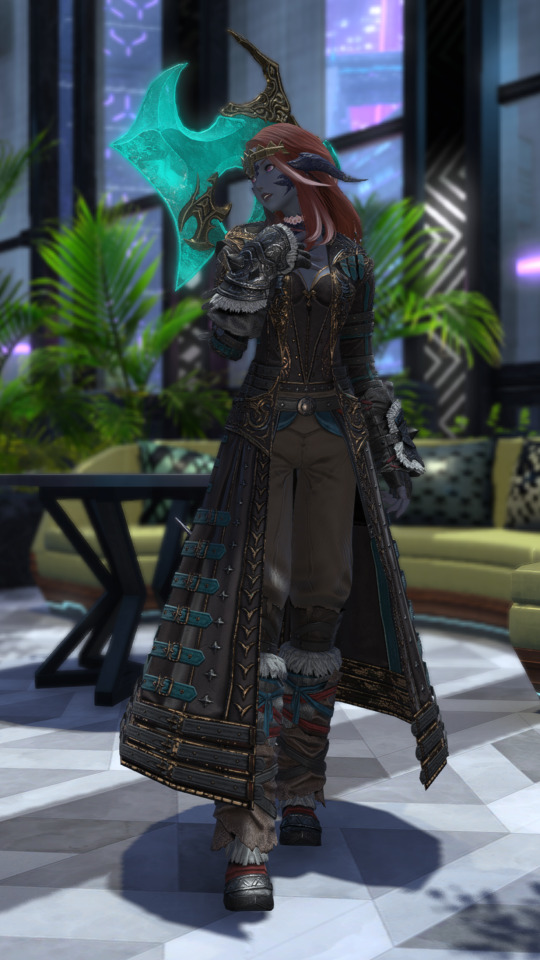


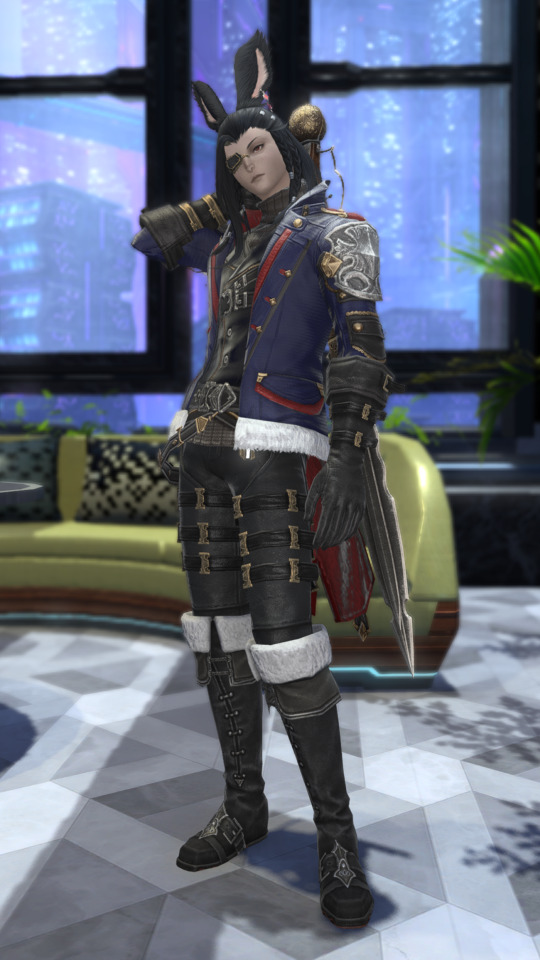







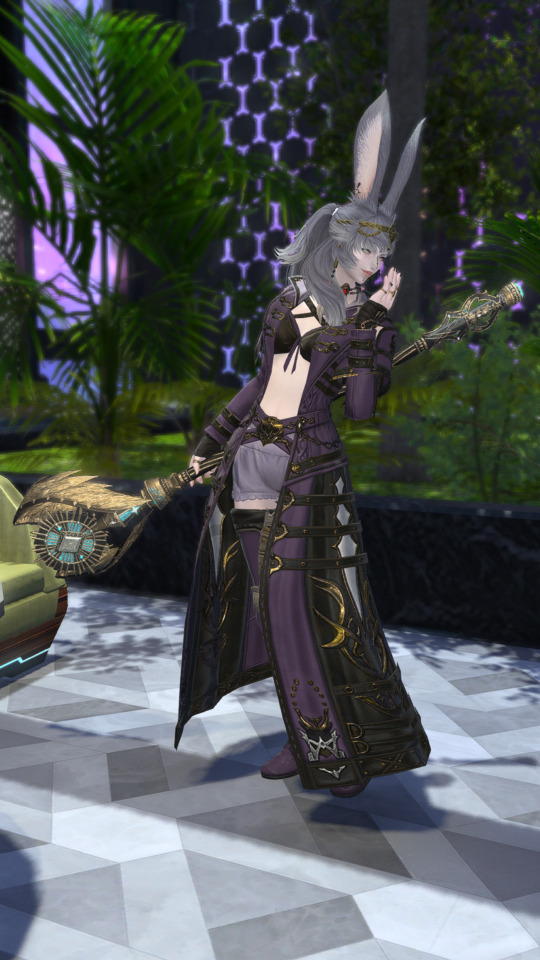


i was gonna do something productive, but then i thought about my alts/OCs in lvl100 outfits and. well!
in order from left to right: Asha Alaqa Sagahl, Aurélien de Sofinoy, Eden Lavellan, Emrys of the Darkened Steel, Félicienne Greystone, Lina Svanasch, Marielle de Dzemael, Mariko Iteya, Merethe de Sofinoy, Myreena, Rian Ashbrooke, Ysera Rowan, Valentin Breliseur, Zelala Zela
#what can i say except all these new glams SLAP. and i am deranged#this isn't even all my ocs it's just the ones o'ravi raids with fdkgjldhgkjh. most of them anyway#i left out o'ravi's siblings and rian's sister#and yes the hrothgal is new. i am not immune to the charms of big cat women#and the funny part is that merethe ended up not wearing any of the new glams jlfgdkghdk. but it's okay her outfit still slaps!#eden going from dragon age where elves are tiny to ffxiv where elves are HUGE is so funny. duality of elf#go girlypop go- live out your tall person dreams!!!! LOL#okay. tags time#asha alaqa sagahl#aurelien de sofinoy#eden lavellan#emrys of the darkened steel#felicienne greystone#lina svanasch#marielle de dzemael#mariko iteya#merethe de sofinoy#myreena#rian ashbrooke#ysera rowan#valentin breliseur#zelala zela
3 notes
·
View notes
Text
11 year old me was out there having galaxy brained takes about keeper while simultaneously being fucking stupid
#11 year old me: hey so shannon keeps emphasizing how beautiful every elf is. wouldn't it be neat if their official art#showed them as having the same diversity in body types and features as humans#like if there were fat elves and elves with acne and big noses and they were still described as exceptionally beautiful. i'd like that#11 year old me was also out there believing gay elves weren't real#duality of man
10 notes
·
View notes
Text
Funny story.......I literally just have this in a drawer. The campaign ENDED 10 years ago. It's fine.

His weight wasn't accurate on the sheet because whatever generator we were using was like "Okay a 5'10" Drow will weigh 120lbs" which....sure they're slender but c'mon. Given his body composition he's around 160lbs.
Also his age, which isn't shown in the photo but is on the sheet, is 126 years old. He was only in his late 20s when his noble house fell and he was forced to flee.
Note "Diety" is left intentionally blank! He can feel Lolth's "pull" if she manifests during a ceremony but he doesn't worship her. She is one of his deepest fears though.
And here's his mini. He lives in a box on my desk. I painted that for his player. I had a huge crush on him at the time. We're married now.


Above is one of the first gposes I EVER took of him. In the tabletop game, when the party first meets him they believe he's an Elf (thanks to an amulet he wears) and through a series of events Durafein finds himself in a situation where he is a Drow pretending to be an Elf who has to pretend to be a Drow to infiltrate a noble house in the underdark which is the absolute last place he wanted to be. He ends up going through with it but not in disguise, just as himself. Everything was going very well until the parties disguises got dispelled....but he remained unchanged.
I think "Traitor indeed." were the Matron's exact words to him. (This was funny to her because the word "Traitor" in Drow is also the word for "Elf" so when she dispelled the party and accidentally revealed he's a Drow instead of an Elf she just makes an awful multi-level pun at him)
12/12/24
If you would/have made your wol(oc) in a DnD scenario what would their character sheet look like?
#ffxiv oc#oc question#ask me about my ocs#my ocs my beloved#canon Durafein#I really liked the duality of him being in disguise#because he had to struggle with it from time to time#FFXIV has some tension between Wildwood and Duskwight#but NOTHING like Drow and Elves#so I try not to bring up his disguise at all#since it's a bit confusing in an FFXIV context#My character Eriyah fell for him thinking he was an elf#She was a half elf at the time and was hoping to afford a wish spell to make herself a full elf#because she just wanted to fit in that bad#She cozied up to Durafein because she saw him as an outsider to elvish society like herself#So she thought maybe he'd accept her
32 notes
·
View notes
Text
i think that kui portrayed kabru's mental health issues in a very interesting way, but it's what makes it subtle to some readers. the fact that he seems so functional to the readers, especially in the first few appearances, not to mention that a lot of his problems and symptoms are not obvious and can only be seen in additional materials, seems like an intended choice from the character writing perspective.
the way kui constructs his character centers around the idea of duality. he switches between two "faces" in the story constantly, he uses two speaking styles (and two pronouns indicating them), he's a tallman who lived with elves for a long time and carries both cultures, he's caught in the conflict between long-lived and short-lived races, he's constantly stuck between two choices in his inner conflicts (what to think of laios? should he prioritize preventing another tragedy or taking away power from long-lived races?), he's bisexual. kui also made him a gemini, yknow, a zodiac sign associated with twins and duality.
there's a certain theme in this and it does affect the way we interpret his personality and choices and it goes beyond text, it's metatextual too. it's a sway between what's hidden and what's shown to the readers about him.
the thing is, i think his mental health issues are meant to be downplayed and hidden, because it's true to his character. what do we notice about him in the main story and what's hidden? well, one of the first things we see is that he's not great at fighting monsters, he suffers from ptsd that makes him basically freeze up just from thinking about them. images of dead people turning into monsters, tearing each other apart and eating each other haunt him, making him feel ill from monster food. he downplays this a lot, hides it from other characters, straight-up lies about it, but at least readers got to see it.
with a keen eye you might notice that he doesn't eat enough food, almost never eats anything on-screen. he mentions that he's never cooked food in his life: wait, kabru, don't you live alone? in that sense "don't you wanna eat?" moment reveals two details of kabru's character at once: we got to see his aversion from monster food related to ptsd, but also his inability to notice his own hunger in general. he's strong and he almost always wears armor, but we know that he often dies in the dungeon. the armor hides that he's pretty scrawny for someone who fights physically, again, something that we can only notice after he takes off his armor (symbolism!).
funnily enough, here we have our first glance at this through additional materials: in the info page about the importance of calories and fat, kui mentions that kabru has lost a lot of weight since he started exploring the dungeon, because he died a lot. what it means is that he doesn't eat enough to cover the loss of weight. subtle, but clever detail.
speaking of him not knowing how to cook, this is another clever detail that hides bigger truth: kabru doesn't know how to do chores, he doesn't take proper care of himself. extra materials reveal to us that kabru lives in the basement, lacking light and clean air and he doesn't know how to clean his room or how to iron clothes and simply... never cared to learn? this is mostly omitted from the main story, even if it does have a place for it: for example, his journey with mithrun becomes infinitely more fascinating, when you know how little kabru cares about himself. but since those chapters are told through kabru's pov, he basically "hides" this from the reader, takes control of the narrative in the same way he tells a polished version of his tragic backstory.
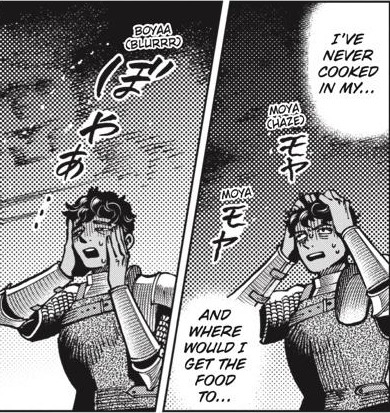

he talks about mithrun's story like there's no connection, like he's not literally looking at the dark mirror of himself. and, ironically, he chooses to not be vulnerable in front of the readers just like young mithrun wouldn't. extra materials give us a glimpse again: when in the main story mithrun said "i can't fall asleep without spell or potion", in the extra comic (literally behind the scenes) kabru says "i use alcohol to help me fall asleep". there's a connection and kabru sees it, but he's not telling it to us. (and yes. there's evidence that kabru is an early-stage alcoholic. we can see bottles under his bed and what he says basically imply that he depends on alcohol: he's not using it for recreational purposes, he's using it as a substance to make himself sleepy and, probably, less anxious. when that dependence turns uncontrolled, it often leads to full-blown alcoholism).
bigger connection to mithrun is of course kabru's refusal to accept his own humanity, to see that he's alive, that he has his own needs and desires. he's suicidal in the same way: he can only see his goal, he doesn't care about his life, he only sees the value of his life in relation to that goal and he never think what's gonna happen to him after he reaches this goal (because he unconsciously believes that "the after" wouldn't happen to him). and he doesn't reflect on it, again, until he's met with a question "what do you want to do?". the way he doesn't see himself as alive is omitted again in the big portion of the story and only really comes up in the end, when he asks "what was the point of my survival?", in a basically joking moment.
but we can see it through the symbolism, through his connection to death in the story, through his eagerness to sacrifice his life for the idealistic goal in his mind. and of course, we can see it clearly through his mirror: there's a strong parallel between kabru almost committing double suicide while chasing his goals and mithrun literally getting himself killed while chasing his own.
what i'm trying to say, it's interesting that kabru uses his control of the narrative to hide his own vulnerability from the readers. maybe mithrun sees himself as leftovers and it's something cathartic for him to admit in the end, but kabru really doesn't want you to see that he feels the same way. that he's also "leftovers". but you see, they are standing together in that panel. as kabru continues to try shielding himself from your view, kui puts the mirror next to him, revealing what's hidden.

705 notes
·
View notes
Text
I don’t remember where, but I think it was right here on Tumblr that I read about a sort of challenge a while ago—to say why we like Spawn Astarion.
Well, since I think it’s a really nice thing to do…
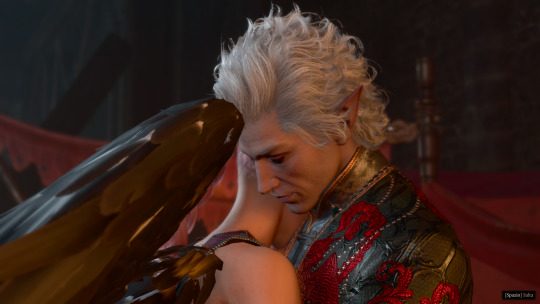
Here are all the reasons why I love Spawn Astarion.
He’s an elf. I’ve always had a weakness for those elegant, slender, and ethereal creatures (no, not you, Halsin, lol). High elves, wood elves, wild elves, drow—love them all. And Astarion is a high elf with the most wonderful stuck-up attitude. I adore him.
He’s a beautiful man. Or at least, I think he is. I love his physicality. Sure, he’s got a great body, but what I especially adore is his angular face. Sharp ears, cheekbones, nose, jawline, chin. I love the elongated and captivating shape of his eyes, and those curls on his head. His hair is gorgeous, and even if he hates poetry (well, after having one carved into his back by Cazador, it’s understandable), I find it absolutely beautiful how his curls wrap around his ears! And also at the nape of his neck and on his forehead! xD
The way he moves and speaks. Of course, this is also thanks to the brilliant performance of Neil Newbon—props to him! I could watch Astarion for hours, talking about this or that, gesturing with those elegant hands and tilting his head from side to side. And when he puts his hands on his hips? Aww. And how can we not mention the expressiveness of his face, shifting incredibly between moments of vulnerability and defensiveness, especially in Act 1. In any case, he’s hugely entertaining, as well as just visually stunning to look at—he truly belongs on a stage, as Shadowheart would say (though maybe not the one with the noose, please!). And those abandoned puppy eyes? End of the world. I can’t resist him.
His sarcasm and dark humor. Lol. He kills me. Sometimes he’s inappropriate, idiotic, or downright an asshole—but apparently, I’m a terrible person because I laugh anyway. He’s such a fun companion, and he never fails to entertain me during the game, especially in his banter with the other party members, which is often hilarious.
His disapproval. Oh yes. I still remember my first playthrough— the more he disapproved, the more I wanted to understand why. And I felt personally attacked, thinking: “Look at this bastard, nothing ever pleases him.” But it added just the right amount of spice to my adventure and my relationship with him. It pushed me to ask questions, to want to engage with him, to understand his reasons and have him understand mine. Like a real person you disagree with. That dynamic always fascinated me—our differences.
Our arguments. I loved arguing with him, even when we saw things differently. I enjoyed playing along when we joked about how we’d prefer to die or which of our companions to feed on. It was fun. And it was even more engaging when things got serious—when we talked about Cazador and how cruel he was, or Astarion’s hunger for power, about bending others to his will, the heroes who never saved him, his willingness to deceive and doom his siblings… I loved every word, every clash, every sharp line, every time he made me grit my teeth. And I especially loved how it made me feel—the patience, the attention, the caution with which I picked every single reply, never backing down just to please him, contradicting him whenever I felt it necessary. And at the same time, the fear of losing him for good if I made the wrong move—because I had sensed how fragile he really was.
The surprise! Yes, when he proposed spending the night together despite all the times we had been on opposite sides. I didn’t expect it, and it made me curious. And sure, at that point in the story there’s a personal motive for Astarion—but we know that the offer only comes if he trusts Tav/Durge enough.
The contrast between the monster and the elf. I think this is one of the most beautiful aspects—his duality. The unbearable dichotomy he’s trapped in. Astarion suffers from being seen and treated as a monster. On one side, he leans into his vampiric nature—his thirst for blood and power (the latter driven by fear as well). But on the other, there’s this deep desire for redemption, for connection, to be understood and accepted, for real intimacy, to belong, to have a place in the world. And all those internal battles make him incredibly dear to me.
He’s morally complex. His view of the world—and the people in it—is very dark, especially early on. Personally, I’m not a fan of the spotless hero type—I usually find them flat and boring, especially when they’re not well written. The Gary Stu kind is just unbearable. Thankfully, that’s not the case with Larian’s characters—the writing is top-notch. But when you combine a well-written character with moral grayness, that’s my perfect character. Again, I love the contrast between good and evil, right and wrong. And Astarion is always walking that razor’s edge, constantly pulled between those two forces that often leave him conflicted. And to be honest, I also believe sometimes the ends do justify the means. Within limits, of course. xD
His backstory. I love characters with tragic, tormented pasts—especially when they manage to reach some form of a happy ending. And even more when they’re written as well as Astarion, with such deep themes and psychological complexity that make him feel incredibly real.
Projection. I won’t go into details, but I’ve been to dark places too, and I’ve had even darker thoughts. I’ve hurt people as well—even if I didn’t know or wasn’t able to do better at the time. I just didn’t have the tools. The positive note is that, like Astarion in the Spawn ending, I’ve managed to accept a whole series of unpleasant events, emotions, and feelings—and learned to live with them. Whether I like it or not, they’re mine, they make me who I am, and I keep them with me. And now I’m in a much better place—safe, loved, and seen for who I am, flaws, strengths, and all. And I love being able to offer my pixelated vampire boyfriend that same opportunity.
The breakdown after Cazador’s death. My God, that scene. That release. The moment where Astarion stabs and screams is already powerfully raw—you feel the rage, the tension, the bottled-up hatred. But then—he collapses to the ground and cries. Fuck. That moment is everything. A whirlwind of emotions so deep and intense I could almost feel them as my own. A cathartic release of everything he had held in for too long—pain, sorrow, grief, relief, hope. God, how I love that moment. And I wish I could hug him, wrap him up, comfort him—but it wouldn’t be right. Because that moment is his. He earned it. And he needs it. Anyone who has suffered that much deserves a moment like that—when it all comes out and slips away, leaving emptiness in its place, as terrifying as that may be.
“This is a gift. Thank you. I won’t forget it.” What can I say? This is a conversation that begins in Act 1, with the first act of trust Tav/Durge offers Astarion, and concludes at the end of his quest—in the good ending. Tav/Durge never saw him as a monster. They always trusted him. They knew he still had so much to give—he could be different. Better than Cazador. And the way I played it, constantly clashing with Astarion from the start over our differing worldviews—hearing those words wasn’t just satisfying. It was everything. Because just as I wanted to know him, understand him, and he became a part of me—he also knew me, understood me, and I became a part of him. And we met in the middle. That, fuck, is the perfect simulation of a healthy relationship between two people. And it’s beautiful. Just thinking about it makes my heart race.
“I feel safe with you. Seen.” It’s pretty self-explanatory, but I’ll say just a couple of things. These are powerful concepts. Especially when we’re talking about someone who has been through everything, and finally finds someone who makes him feel safe. Someone who won’t hurt him. That’s huge. And the concept of being seen? I think that’s the most fundamental desire every person on this planet has. And Astarion waited 200 years to feel that. It’s moving. And so deeply fulfilling to hear.
Spawn Astarion’s kisses. The sweetness. That soft side of him that comes out. The way he looks at Tav/Durge as he leans in—his face relaxed, his eyes shining, that smile on his lips. Love, in its most tender form.
Unique dialogues from Spawn Astarion. I’m referring in particular to the confrontation with the Gur after Cazador’s death, and to the moment when Durge wants to leave him out of fear of causing him harm. I find the way he handles these situations absolutely beautiful—it perfectly shows how much he’s grown, and how willing he is to open up to others, to consider their feelings. Even those he once saw as old, despised “enemies,” to whom he spares the pain of watching their children turned into ravenous vampire spawn. That line always moves me—I think it hits incredibly hard, especially given the context and his history with the Gur tribe. And then, of course, there’s the confrontation with Tav/Durge after the betrayal involving Mizora, which again shows how much he’s grown—even in terms of self-perception, understanding his limits, and asserting his right to say no. And what he says at the top of the Netherbrain, when Durge tries to claim it for Bhaal, perfectly reflects how his priorities have shifted since breaking free from Cazador’s mindset.
Self-acceptance. It's such an important, healthy concept. Astarion is perfect just the way he is. He has nothing to fear in that regard—he can simply exist and express himself. He doesn't need more power; vulnerability is okay, being fallible is okay, being full of flaws is okay. Being afraid is okay. You're still worthy of love. And the world isn't this terrible place where you have to crush others to survive—you can find your place among others, with others, and live with others. And it's beautiful to see how Spawn Astarion begins to internalize these ideas.
Facing his fears instead of indulging them. I’ve done the opposite for so long that I can honestly say—it’s usually a terrible idea. Because most of the time it means running away and giving something up. But Spawn Astarion doesn’t do that—he fights. He chooses the hard, uphill path of self-discovery and acceptance. With all the consequences that come with it—no matter how painful, like losing the sun or dealing with the gnawing hunger. It’s an act of immense strength and courage.
He takes responsibility and makes amends. That’s called redemption. And yes, he couldn’t refuse to obey Cazador’s orders—he had no choice—but when the ritual is within reach, the choice is entirely his. The lives of his former targets and his brothers and sisters are in his hands—an enormous burden on his shoulders. And in the moment he gives it up, he rights a wrong both suffered and inflicted. He saves himself and all the other vampire spawn, freeing them from Cazador’s influence and from the path the vampire lord had laid out for them.
He becomes an antihero. Yes, Astarion is better than Cazador. He’s become kinder, more open toward others, more willing to help, and more optimistic about life. But he hasn’t become a saint—he’s still a bloodsucker, and deep down he’s still the lovable rogue I fell in love with, always ready to say something inappropriate, foolish, or even cruel. And to take advantage of situations when he can. I adore him! But he’s still a charming scoundrel with a whole world of possibilities to explore, and plenty of room to grow—both in his relationships with others and in the one he has with himself.
There’s probably more, but I think I’ve written plenty already—and I’ve got a real life and a family breathing down my neck, lol. Let’s just say these are the main reasons why I love Spawn Astarion, why my relationship with him has become so precious to me, and why it’s so damn hard to romance any other companion in camp when that damned vampire is around. Lol.
#astarion#astarion ancunin#baldur's gate 3#bg3#bg3 astarion#baldurs gate 3#baldur's gate#baldurs gate#baldurs gate 3 astarion#astarion bg3#baldur's gate astarion#spawn astarion
152 notes
·
View notes
Text
Marcille’s dungeon lord outfit is about being stuck in an inbetween



Kui combined a dress from her mother with a hat for children. It’s adulthood vs childhood. The dress is tallman fashion while the earmuffs are elven. It’s about emotions and maturity. Stability and instability. Growing & potential vs having grown & knowing yourself. It’s about her cultures and expectations and how can she possibly keep up with all of them, like the genius child she was portrayed as? It’s duality it’s conflict it’s being pulled in opposite directions. It’s about identity.
Marcille wants to have all the answers and wants them all already, she already acts like she has everything figured out more often than not, when it comes to ways to harvest mandrakes or her image of Falin and Chilchuck and orcs or her rigid sense of ethics, but the story does show that she had growing to do, plus her main goal beyond keeping her friends safe and near her is that pursuit of knowledge for what she doesn’t yet have answers for— rewriting the laws of life and death. But, as we’ve all been told before, death is simply a part of life and we have to make our peace with that one way or another. Like Marcille says in the last chapter, this was in large part the lesson and arc she’s had to go through. A lesson that Marcille’s mother has learned herself, one that she has accepted and tried to pass on to her daughter, which didn’t work and kickstarted Marcille’s pursuit of extending lifespans. Marcille has to settle with uncertainty, with knowing life can end at any moment and knowing this is who she is even if the world has no answers for her as to what that means, she has to come to terms with ambiguity and inbetweens.
Marcille’s relationship with her mother is very interesting because it’s shown all in small moments and implications, but we do see that Marcille’s mom is arguably her biggest role model.

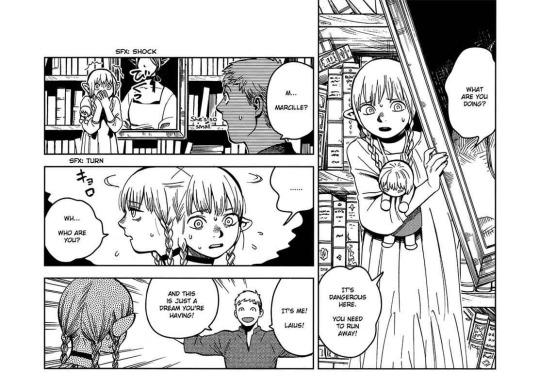


She’s the one who shows up in Marcille’s nightmare about monster food early on, she is who told Marcille she’ll have to bear loss througout her life due to her lifespan, Marcille wears a choker like she does, it’s debatable that Marcille mimics her demeanor to seem more elven and dignified, in Marcille’s true nightmare she hides behind a portrait of her, she was the only living elven role model Marcille had around. Mother, who didn’t let grief over her husband rule the rest of her life, having even remarried, mother, who’s a court mage, mother, who pursued a life she wanted even if it cost her. And we do know being an elf is important to Marcille! She seeks to conform to elven beauty standards rigidly, both in gender presentation and things like facial hair, and she’s masked as one since she was enrolled in the magic academy, as far as we know her first time away from home and her first big period of social contact since she isolated herself with chickens and books when she was younger, because she had no peers. Books like the daltian clan, with an aestheticized all elven cast with the one exception of the half-elf character she deeply related to.

Marcille’s bangs are also half down and half cut. Before she had to cut some hair to make familiars, long bangs were what Marcille wore for years, meanwhile in all of Marcille’s childhood flashbacks including at the magic academy her bangs were always cut short. As we know, hair is important to elves. Her hair is elfness. Her hair is elegance. Her hair is her age. Her bangs are uneven now. It’s part of accepting her precarious weird spot in an inbetween, half up half down haircut. Acceptance on her own aging, that there’s no empiric answer for what Marcille’s equivalent age is in elf or tallman or other, maybe just a ballpark if even that. Answers which are what she’s most desperate to know. What do you mean that student over there has got an astronomic result on her dungeoneum and what do you mean she doesn’t really care for how you did it? Falin who’s thus showing her another way to be, with less self-made pressure, that you can just go with the flow- that you can just… Be.
Her hair being all down and messy as a dungeon lord is part of making the characters and audience understand that Marcille is out of it, but… Like her barefootness there’s some flexibility it implies, for Marcille who’s so rigid on appearance. Accepting her hair to be messy, a sort of shedding of who she is even as she’s overdressed and trying so hard to look like something she doesn’t feel as.
That’s why her outfit makes her feel courageous. Because it makes her feel different from who she is otherwise, because it grants her a look she feels naked without, even with barefeet and messy hair. It’s externalizing how she’s been trying to hold it all together and all her confliction and her feelings, offering some catharsis, no more hiding herself, she’s a half-elf trying to do dark magic. Clean Marcille, clean clean Marcille— Overthinking the dressing, the superficial the aesthetic, without looking enough at the body it’s covering up, the laws of the world the ecosystem of the dungeon the opinions of her friends’— what’s standing right in front of her face, the underlying thing holding up the rest of what she’s trying to change, what’s truly important. She’s back to being like with meeting Falin, overfocusing on the details and the nitpicks and the theorics while oblivious to the slimes and the bats and the balance of mana in that small cave dungeon. She has the dress and the hat but as a whole she doesn’t look like a slay queen or a princess or a cool sorceress or even like her mother, she just looks like a mess.


Ultimately after calming down, she takes the earmuffs off. She lays down her childhood trauma and leaves behind its grip on her and moves forward in the dress, with maturity and emotional intelligence and logic to deal with her current situation instead of coping mechanisms and desperate grasps for control. And then when the dungeon lord becomes Laios her dress poofs, she’s in her very plain pajamas, plain Marcille, and it’s that Marcille who goes forward to help Laios save the world and defeat the demon. Hence why post-canon she starts dressing in similar dresses to her mother as well, and starts wearing more black. Black here is a color associated with her mother. She keeps her own touch and color here and there, like her red choker instead of a black one, but it’s a stark and sudden difference. She’s matured.
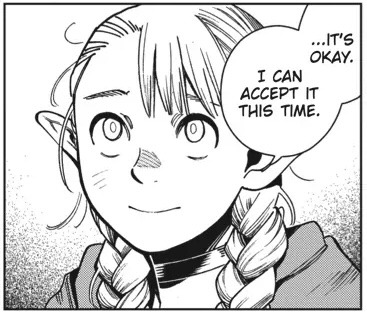

Her dungeon lord outfit is a coming of age outfit in a very literal way. A bridge between childhood and adulthood. We see her struggle metaphorically between the past and the future, moving on or holding onto trauma. The dress, from her mother, with cleavage and low cut sleeves and a lace gap going down to her stomach and a very short risqué skirt cut, represents maturity but it was very purposefully contrasted with the earmuffs, a childish piece of accessory associated with youth. This shows her mental state, battling with her emotions, wildly fluctuating between her academic put-together powerful self and the childish emotional outbursts the pressure is causing. Time moves on too fast but she’s not growing up fast enough to keep up or make the academic breakthroughs she wants— time is always running out and she’s both too young or too old she’s pulled in both directions and she can never be up to standards. It represents her struggle with her lifespan, her struggle to fit in, to know who she should be and what she should be doing.
Her friends aren’t afraid to say it like it is and bring back her feet to the ground instead of up in the clouds of fantasy and power, from where she was, her feet back on the dirt of where they are right now instead of the theorics of "when" and "then" and "forever". She’s weird, she’s unique, in some ways she doesn’t fit in with any group anywhere, and that’s ok and she’s accepted that it doesn’t mean she can’t feel belonging and joy as herself with her flawed friends in a flawed world. After all they did stick with her even after seeing her whole tantrum and embarrassing breakdown makeover. Personally I do say, slay queen.

You’re still here? If you’d like a full look at Marcille’s dunlord outfit, I made an entirely too long analysis of it here, this is just an excerpt of the most canon section.
#I love Dungeon Meshi bc inevitably I reach a point during analysis I’m baffled by how far I can get and i pause and look back#and no no i’m not hallucinating the source material is just that potent and thematically rich and fascinating#I’m still a princess when there’s nothing left to wear <3 <- Girls by Patricia Taxxon#Dungeon meshi#marcille donato#analysis#meta#I don’t think i can tag this bite sized fumi#Spoilers#dungeon meshi manga spoilers
138 notes
·
View notes
Text

The duality of elves
426 notes
·
View notes
Text
I am Near, I am Here: Rayla, the Moon, and Love as Presence
I was originally going to add this to @raayllum's post about Rayla's lullaby and Ethari but then the number of screenshots I was taking before I even started to write indicated that it had gotten out of hand.
Rayla's lullaby ties in with a lot of stuff going on in s6, most of them related to her relationship with Callum, which has its last barriers broken down and leaves their bond stronger than ever. Surely so strong that nothing in s7 could possibly challenge it. Most of Rayla's life has been defined by absence—the absence of her parents, her own forced absence from her community, her chosen absence from Callum. The lullaby, however, affirms that even when the moon appears to be absent, it is still there, and has been all along.

This is an interesting facet of the Moon arcanum, which is usually focused on certain dualities—life and death, reality and illusion, presence and absence—but also on the permeable borders between them, on change and cycles between those states.
We also actually have a window into Rayla's own understanding of the Moon arcanum—her first transformation into Moonshadow form in Bloodmoon Huntress. Look, just... bear with me, okay?
It's explicit that not all Moonshadow elves can achieve Moonshadow form, and that for most it takes months or years of meditation and training. I read this as that, while Moonshadow elves are born with an innate connection to the Moon primal, attaining Moonshadow form requires developing a deeper understanding of its arcanum. Runaan describes it as being about the balance of life and death:
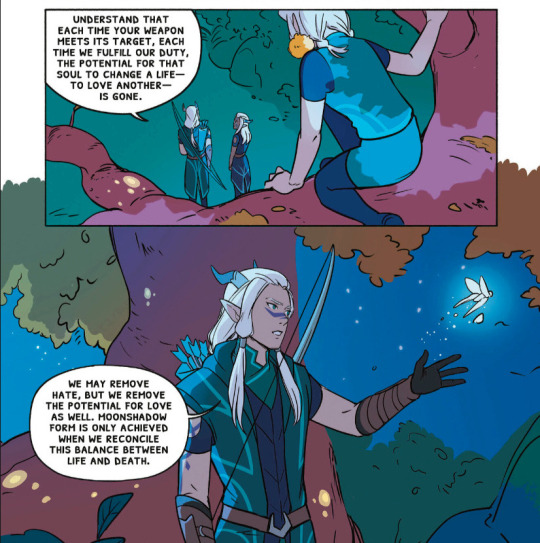
Rayla can't reach Runaan's understanding of the Moon arcanum, which is somewhat hilariously about recognizing yourself in your enemy (something Rayla winds up being very good at) and understanding why you have to kill them, anyway (something Rayla winds up being very bad at).
What does work for her to achieve Moonshadow form at a terrifyingly young age is focusing on her wingaling, and a statement from Ethari:

Both are about love as being present—something Rayla is conflicted about in her parents' absence. The wingaling represents a promise that Ethari and Runaan will always come for her when she's in need. Ethari's statement is originally made in the context of explaining that Runaan's devotion to his people may require him to make great sacrifices, but that devotion can also be the smallest act of presence, and both are necessary. Her understanding of the Moon arcanum is about that presence—the moon that is always there, even at times when there is no light.
As Rayla is struggles with why her parents Runaan leaves those he loves to risk his life for others, Ethari explains that he and Runaan both know he may never come back, and that is something Ethari has to accept because Runaan can't be separated from that devotion and duty when it comes to loving him. What's missing from the conversation is acknowledgement of the trust and commitment that underpins that acceptance—Ethari's trust that Runaan will come back, and Runaan's commitment to do so.

The moon is there even when it has waned to invisibility, but it goes unstated that it also always waxes back to full. You can trust that it's there when it can't be seen, and you can trust that its light is coming back. You can trust that it's there when it can't be seen because you can trust that its light is coming back.
I am near, the lullaby says. I will be with you again soon. Until then, remember that my love is always here.
That's an understanding that Rayla crucially doesn't have when she leaves. In Dear Callum, she never once promises or even suggests to Callum that she will come back to him, even if she finds Viren. The closest she gets is the lukewarm:
I wish I could say that we will see each other again, but I don’t know if we will. I hope so.
So not only is she shattering the trust Callum had in her by abandoning him after she told him they would stay together, she won't even offer any real reassurance that she will return. Because she doesn't really think she will. Her only commitment to keep him safe, and as long as being separated accomplishes that, she will stay away. How is he supposed to accept that? What reason could he ever have to believe that she and her love are there, even when out of sight?
And yes, all of this does stem from things she learned from Runaan—Mr. "I do what I must so those I love don't have to"—but the key difference is that when push comes to shove, Runaan understands something else:
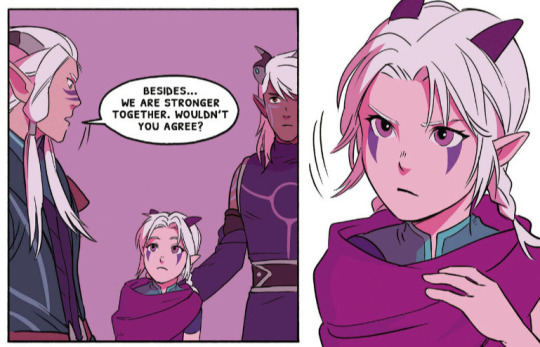
The same thing that Tiadrin and Lain did:
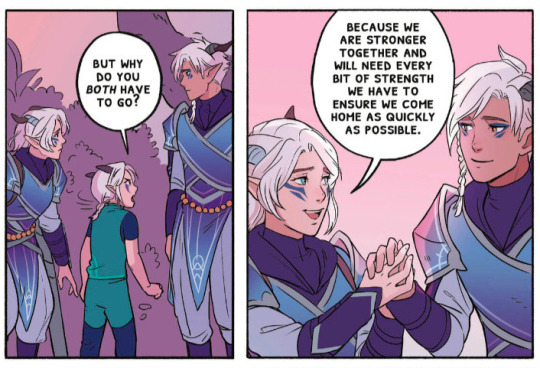
And that Amaya does:


That love is ultimately strengthened through presence, and through presence it strengthens us, in turn. When we open ourselves to strengthen those we love and trust them to strengthen us, then our love cannot be diminished by distance or absence.
Somewhere between Bloodmoon Huntress and s1, Rayla loses sight of that, and she doesn't rediscover it until confronted by Amaya over how her leaving harmed Callum—and how it harmed Rayla herself. Amaya isn't the first to tell her how she hurt Callum, but she's the first one to really convey to Rayla that keeping her secrets and burdens from Callum isn't sparing him from their weight and pain, only weakening her. It has always weakened her. Until she turns that around, she is denying both of them their best selves—her as the light that will bring him out of any darkness, him as the anchor that will bring her home from any distance.

The end of s6 beautifully shows the culmination of all Rayla has learned in the slow return of her relationship with Callum, and to top it off, she gets to demonstrate it to Runaan. (Since Callum already knows.)
Trapped in the In-Between, Runaan is consumed by guilt and self-loathing—he fights Rayla's attempts to guide him back to life because he doesn't believe he deserves to go back. He's too ashamed to want to go back. The way Rayla brings him back is twofold:
She reminds him of his promise to Ethari—his promise to return. She made no promise to return to Callum when she left. She probably wanted to, but she believed that the sacrifices that might be demanded of her would be more important. It would at least be out of the question to return before finding Viren, but in the end that's what she does—she returns to Callum, even though she must do it defeated, ashamed, and alone.
She also tells him that she needs him. She needs her father. She's weaker with him not there for her. When she left Callum, she genuinely believed that things would be better that way. He'd be better off safely away from whatever danger her search brought her, and making sacrifices for the people she loves—taking on difficulty and danger alone, so they don't have to—has always been her duty. She's spent three seasons re-learning the strength she has with Callum, now it's time for her to do the same with Runaan.
Rayla is very different now than she was the last time they met, and Runaan—like Callum—is going to finally see the truth of her: that she was never meant to be an assassin, but not because of failure or weakness. She was always meant to be a hero.
#the dragon prince#rayla#rayllum#runaan#moonshadow elves#i just spent a ridiculous number of hours writing rayllum meta?#i think i need an adult#to check if i have a fever or maybe do a drug test#kradogsmeta
89 notes
·
View notes
Text
Hey by the way if anyone tries to deny Kabru is a judgy bitch I’ll send you the panels of him calling everyone worthless
Respect his duality he’s a good boy who genuinely wants the best for everyone but also thinks he has to do everything himself despite being the Least Qualified Ever because no one else lives up to his standards
He doesn’t even want to look at monsters but oh well every single other person is a piece of shit let’s go get my friends killed over and over again
He’s interesting BECAUSE he’s not one dimensional Good Pure Boy all the time, he’s a judgy manipulative little shit who will eat monsters if it gets him towards his goals, which are “nobody should be killed by monsters actually” and “i want to know what the fuck is going on”
He coulda had ONE honest conversation with Laios and known literally everything about him, Laios has never met a filter
But Kabru was raised for a good chunk of his life (6-18) by Milsiril, and for all he believes elves can never understand short lived people… he picked up the whole “I must be secretive and always conceal my own motivations”
He only breaks under literally the most intense high pressure situation he’s likely to see in his life, which along with being the potential goddamn apocalypse is also a rehashing of All Of His Personal Trauma oh and also Every Suspicion He Ever Had About This One Guy
He’s not more honest because he’s an honest person, he’s more honest because he forgot how sentences work when he finally caught Laios and doesn’t have the bandwidth to play the constant 4D chess in his head that underpins his EVERY INTERACTION WITH EVERYONE EVER until Marcille takes the lion
Kabru’s a pretty good person, with extremely good motivations and goals.
He’s a manipulative son of a bitch who will do anything, anywhere, anytime, to meet those goals, and spends a solid chunk of his time and energy on reading people so he can be someone they like… regardless of his own feelings.
He’s the living The Good Of The Many Outweigh The Needs Of The Few, and solidly puts himself in with “the few” by doing shit he hates because he thinks it’ll help.
Isn’t that more interesting than “oh he would never manipulate anyone, he’s so nice and good all the time”?
#kabru dungeon meshi#delicious in dungeon#dungeon meshi#this was supposed to be short but i am buzzing so#dungeon meshi spoilers#delicious in dungeon spoilers#also tbh why kabumisu has me by the throat#kabru’s sacrificed himself on the altar of his goals for so ling#long even#becoming everything for everyone so they like him and don’t get in his way#he Needs to get back in touch with himself#and stop becoming whoever his latest target will like#and mithrun could not give less of a fuck who kabru is if he tried#which is why kabru can finally drop the act and just be himself while they’re alone in the dungeon#he’s not trying to read and anticipate mithrun half as much as he does laios and That Is Actually So Much Better For His Mental Health#like yes boy give up on trying to please people#it’s a fucking endless pit get you a man who doesn’t give a shit and will tell you not to too#and then even when kabru stopped trying to be someone mithrun would like#that sneaky fuck won mithrun over anyway and THAT is why they are OTP shit
293 notes
·
View notes
Text
Reflecting on Andrzej Sapkowski's Thoughts on Le Guin & the Healing of the Waste Land
In re-reading Pirog, or There’s No Gold in the Gray Mountains (1993) by A. Sapkowski—perhaps one of his more well-known essays on the state of fantasy, and the genre’s reception in Poland in particular—I cannot help but get stuck on how he analyses Ursula K. Le Guin’s Earthsea series. It resonates with one very particular strand that Sapkowski plucked on at the heart of his own books: the duality of human nature. Good and Evil, yes, but also: male and female. As psychological and symbolic polarities balancing the psyche.
‘Already the Archipelago of Earthsea itself is a deep allegory - islands scattered across the sea are like lonely, alienated people. The inhabitants of Earthsea are isolated, lonely, closed in on themselves. Their state is such, and not otherwise, because they have lost something—for full happiness and peace of mind…’
The loneliness and alienation, the Waste Land of the human heart, is a recurrent motif in The Witcher. Its influence is felt not only in the plot threads of our protagonists, but also in those of such characters as Emhyr var Emreis, Vilgefortz, the Rats, the Alder King, Avallac’h, anonymous elf who burned down Birka, and humanity and elves in toto. It is just that antagonists rarely reveal their hearts to the protagonists (and to the reader)—if only to have a blade struck it through.
‘Ged’s quest is an allegory, it’s eternal goodbyes and partings, eternal loneliness. Ged strives for perfection in constant struggle with himself and fights the final, symbolic battle with himself, winning by uniting with the element of Evil, accepting, as it were, the duality of human nature.’
Le Guin broke out of the Tolkienian mould, in Sapkowski’s words, by focusing on symbolism and allegory; on the inner journey, as a reflection of, and as affecting, the external world. It is in the recognition and healing of the Waste Land that Evil, or potential Evil, could ever possibly be undone.
In The Tombs of Atuan, the allegory takes us into the Labyrinth of the Psyche, which Sapkowski compares with the Labyrinth of Crete. The Minotaur within is not a monstrous beast, it is ‘pure and concentrated Evil, Evil destroying a psyche that is incomplete, imperfect, not prepared for such an encounter.’ Evil gets close to a psyche in conditions of imbalance, loss, alienation, abandonment, incompleteness.
And then Sapkowski gives the entire thing a gendered spin, bringing Le Guin’s writing closer to the archetype he himself uses.
‘And into such a Labyrinth boldly steps Ged, the hero, Theseus. And like Theseus, Ged depends on Ariadne. Tenar is his Ariadne. Because Tenar is what the hero lacks, without which he is incomplete, helpless, lost in the symbolic tangle of corridors, dying of thirst. Ged thirsts allegorically - he's not after H2O, but after the anima - the feminine element, without which the psyche is imperfect and unfinished, helpless in the face of Evil. … he is saved by the touch of Tenar’s hand. Ged follows his anima—because he must. Because he has just found the lost rune of Erreth Akbe. A symbol. The Grail. A woman.’
Be it the loss of the Alder King (Shiadhal) or Avallac’h (Lara), or Emhyr’s (sacrificing his wife Pavetta, and having been sacrificed by his own father), or Vilgefortz’s (abandoned by his mother, falling in love with a sorceress and coming to hate her for the power she held over him via his feelings for her), or the wartime children of contempt (written off and abused by everyone and everything), the wound remains archetypal and notably alike.
(Not to speak of The Witcher’s protagonists into whose hearts we do see, and in whom we witness the transformation of the Waste Land of the heart in ways which eludes—or only with the very first fleeting steps is beginning in—the rest.)
Love is the essence. Love and lovelessness walk hand in hand at the heart of everything in The Witcher, and with them the good and the evil. What matters in the end, as in all good fantasy, is heart—knowing it, seeking it, letting the spirit flourish in its presence. To gentle the heart. To remain human.
As Tenar to Ged, in Sapkowski’s reading of Le Guin, so Ciri to oh, so many characters, in my reading of Sapkowski.
‘Now Tenar grows into a powerful symbol, into a very contemporary and very feminist allegory. An allegory of femininity. … Tenar leads Ged out of the Labyrinth—for herself, exactly as Ariadne did with Theseus. And Ged—like Theseus—can’t appreciate it. … he gives up, although he likes to enjoy the thought that someone is waiting for him, thinking of him and longing on the island of Gont. It pleases him. How ugly male!’ […] ‘After an eighteen-year break, Ms Ursula writes “Tehanu,” … the broken and destroyed Ged crawls to his anima on his knees, and this time she already knows how to keep him, in what role to place him, to become everything for him, the most important meaning and purpose of life, so that the former Archmage and Dragonlord stays by her side until the end of his days…’
---
Marginalia
This motif is universal in how it explores the psyche, but it is also very particular, because Mr Sapkowski’s influences include Bettelheim, Freud, and Jung, as well as Campbell, the Wicca movement, and the feminist current in fantasy. It is evident then, I think, how the balancing between the male and the female is seen as essential for the flourishing in either’s soul.
As seen in ”The World of King Arthur” (1995):
‘The wound of the Fisher King has a symbolic meaning and refers to the beliefs of the Celts - the mutilated king is unable to perform a sexual act, and the Earth he rules cannot be fertilized. If the king is not healed, the Earth will die and turn into La Terre Gaste, the Waste Land. The wounding spear is a phallic symbol, and the healing Grail is the vulva.’
Or as in Joseph Campbell (1988):
'The big moment in the medieval myth is the awakening of the heart to compassion, the transformation of passion into compassion. That is the whole problem of the Grail stories, compassion for the wounded king. ...the awakening of [the] heart to love and the opening of the way.' [...] '...when the center of the heart is touched, and a sense of compassion awakened with another person or creature, and you realize that you and that other are in some sense creatures of the one life in being, a whole new stage of life in the spirit opens out.'
The word "compassion" means literally "suffering with." Nobody ought to remain alone in suffering. Evil happens so very often as a consequence.
In Excalibur (1981), sick Nature comes alive again when Arthur touches the Grail and wakes from apathy. Of the Grail stories, however, it is Wolfram von Eschenbach’s which speaks to the Witcher’s author’s own sensibilities the most.
‘Let's look for the Grail within ourselves. Because the Grail is nobility, love of neighbor, and the ability to have compassion. True chivalric ideals, towards which it is worth and necessary to look for the right path, break through the wild forest, where, and I quote, "there is neither road nor path." Everyone must find their own path. But it is not true that there is only one path. There are many of them. Infinitely many.’ - Andrzej Sapkowski, The World of King Arthur
Only then does the land bloom again in snow-white blossoming apple trees.
#the witcher#wiedźmin#the witcher books#andrzej sapkowski#the witcher meta#arthuriana#joseph campbell#ursula k le guin#ciri#auberon muircetach#emhyr var emreis#avallac'h#vilgefortz of roggeveen#geralt of rivia#yennefer of vengeberg#the grail myth#one day i will write a comprehensive article on this particular side of his writing#because his postscript is all over the place about this#the witcher essay
58 notes
·
View notes
Text
also releasing a preview of the DAV tarot cards this early is nuts
DAV spoilers again let's look at them together yippee

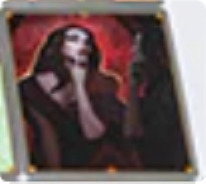
this looks like the lady Lucanis is fighting in the trailer and she lowkey bad I'm jealous she can be an evil milf but my Rook can't

Taash ?? Taash endgame/resolution card maybe

he's going to fucking die Emmrich is going to die or he will become a skeleton man and if this aint confirmation idk what is. I assume the latter option is Morrigan's doing.
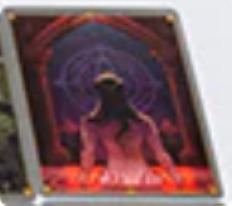
blood magic ritual ? again probably related to the milf. nothing to see here but I think it looks hot so I'm including it for reference later.

I could be reaching but TO ME: this looks like Anders

elf with big jugs.....Natalene has competition. they're connected, so there's some duality at play here. probably origin cards for Dalish elves.
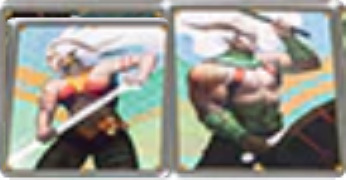
same with these! qunari origin cards??
59 notes
·
View notes
Text
Qunari Origins and the Forgotten Ones[?]
I'm making a rough-thoughts-about-Qunari-dogma-and-origins post because I must store the thoughts somewhere before I can dissect them further but...
I'm very interested in the phrasing of this codex entry in DA2 (especially after the confirmations/revelations of the ancient elves' origins in dav):

[Not really] spoilers [but lore speculations] below!
note: this is definitely me putting too much emphasis on the extent of foreshadowing a series can be accredited with, and absolutely stretches the written intention too far for what could possibly be considered "traditional analysis". There's every chance this codex is written this way stylistically, but alas, I want to work on something constructive and interesting in the dragon age lore to find that joy again!
Qunari view themselves as a part of a "whole"--similar to how dwarves are part of a larger whole as well (the Titans). You could accredit this reading to being one of a "pack" mentality. Or how dragons can often "conjure/call" their wyverns/dragonlings to come to their aid or follow an instruction.
They also have a spirit outside of their "body"--their military. So, like the ancient elves that built themselves from lyrium they are a duality of solid with spiritual essence "hidden" from the face of southern Thedas.
We know the Qunari came from across the Boeric Ocean, Par Vollen is not their native homeland. There's lore about them having horns because of dragon blood (supposedly mages back in the day trying to make more powerful warriors)--this leads way to my thought process of the Qunari being bound to a genesis that is, essentially: military experiment (the way Tevinter breeds Altus mages, they would endeavour to make a race of unmatched conquering power).
However, that's too reductive and too cheap (i feel) an explanation for how that origin could also explain their dogmatic religion and their culture's "iron-grip" on expressions of individuality outside the Qun. There's too much precision in their structure to simply bind it under the tagline of: "we're like this to tame the dragon blood and keep the fires in check--lest they consume us like they do the talvaashoth or the deserters".
So now I'm thinking, there must have been a trigger that forced their society to rely so heavily on the dogmatic rigidity of the Qun--a set way of being, of having a role and understanding of where you stand in the larger scheme of things. Which had me wondering about what the Forgotten Ones did that was so bad that the Evanuris themselves took time off the Titan War to war with them! (presumably, the timeline is insane--and the Evanuris war lasted at LEAST 1000 years according to Solas).
So here's my very flimsy, very-not-at-all possible interpretation. Anaris and the Forgotten Ones could have done many things to brand them "worst of the worst" but only one idea seems to track with the possible theme of a "perfect vessel" that is strewn across their stories:
Formless One's first appearance as a dragon, one they feel is limited and not a true representation of their essence--and the haunting narrative of seeking a true body
Anaris, obviously, everything with his arc linked in Bellara's story, wearing a mask, and then turning to dramatic goop on the floor.
Gaxkang (arcane horror demon) having "Unbound" in their name, if we consider spirits in bodily vessels "bound", this could be a "refutation" kind of title. Like if John Snow's title was John the Wise (in jest).
Imshael, he can shift "between the forms of fear, rage and pride demons" [and in the concept art Imshael had a female persona, so I do think having an 'identity'/'prime body' is intertwined in his/hers/their ethos too].
all except maybe Xebenkeck have a loose thread to this "perfect vessel" tapestry my brain is weaving--but she was first, I think, and she is also a desire demon, whom Qunari share a resemblance with horns-wise [Mythal too, but that's more because of "dragon" effigies in her statues and headpiece]. Xeb is possibly their most 'shallow' entry to the Forgotten One's lore--or equally the most cohesive, since desires are changing, and make of people malleable subjects--deals with the ability to mould or cause chaos.
Loose note: Xenon the Antiquarian, I know it's probably the "X" of it all, and they're probably named after the gas "Xenon", but their wanting of "immortality" and then the collection of rare and powerful tomes/trinkets, being tricked by Yavana or another Witch of the Wilds to be a withered, frail thing in a husk? He's definitely related to the Executors--at least! And they're most likely the lingering influence of the Forgotten Ones (possibly).

[Imshael's letter in the Fade; datv]
From the wiki on Xebenkeck (sidenote: girl how do you pronounce your name? is it like Xoloitzcuintle?! is it Ch-eben-kek? or is it a mandrin X like SH-eben-kek?):
"“The first of the magus cast themselves deep in the Fade in search of answers and power, always power. They found the forbidden ones—Xebenkeck, Imshael, Gaxkang the Unbound, and The Formless One. Many conversations were had and much of the fabric of the world revealed. And thus the magic of blood was born.” ―unknown mage[1]"
the dao codex entry makes it sound like the Forbidden/Forgotten Ones discovered blood magic, but I don't think that's right, considering ancient elves used blood magic neutrally (it's only seen as an 'evil' art in modern thedas--because of the side-effect of having mages be oppressed and locked away in religious tower blocks). I think they possibly taught modern humans/elves/mages about blood magic again, and modern humans were to blame for it being used mostly in a negative/desperate light.
Now binding a spirit is usually what turns them into a demon. It corrupts their purpose and is also a great theft of autonomy from the spirit's side. Dragons are ancient, possibly the oldest "physical flesh" form besides Titans. Considering the ancient elves were losing the war with the titans because they were possibly few in number and not nearly as strong physically, I'm inclined to believe that maybe the Forbidden One's became twisted into the versions we know today because they committed great sacrilege against the Elvhen, the dragons and the Titans in one big gesture: creating the qunari as a form of making the ultimate form.
In my head, I can see them as researchers, which leads well to them toying with humans mainly out of interest to see the results unfold: to orchestrate chaos (this will play in the rigid qun structure later).
To make the ultimate form, they'd need spirits, lyrium and dragon's blood--and I'm willing to bet none of the participants in this "research" were entirely willing.
And then what if red lyrium is like a cyst from these experiments? Dragon's blood from the experiments that tainted the Titans somehow, gave them that "fire"; that "rage"; that "inflammation"? Which could also explain how Imshael knew how to cure red lyrium poisoning.
So they forcibly pull other spirits out of the Fade (maybe luring them out with the "unbound" of them, or with desire?--or the illusion of choice or fear or rage), binding them to a lyrium body instilled or infused with dragon's blood (maybe creating red lyrium as we know it) and then forging the qunari (but they were possibly defective? possibly hunted down by "mythal/another dragon effigy-linked woman" that made them flee their home the first time?).
So if the Forbidden Ones represent chaos, it makes sense that the surviving twisted spirits left confused in their new bodies would crave structure, and why their minds would build a dogma that leashed their chaotic structures with enforced rigidity, and it would also explain the Qun's inbuilt fear of "unchecked" power; of magic and the Fade.
As Solas said "Chaos breeds a desire for simplicity." Or something like that.
Also the firebreathing, heightened sense of smell, but also Bull's odd reaction to the Fade in Trespasser (we know he sees it differently than both elves and humans--but it's discordant, confused, almost like how trauma warps/frames understanding).
Very on the nose also: Taash. From Ataashi. A Little Dragon from Dragons. That's all for now folks.
TLDR: Forgotten Ones possibly wanted to make an "ultimate weapon form" for themselves by using unwilling spirits (mind and soul) to fill the lyrium flesh (to make arms, legs, ears...) but the blood is sourced from dragons (fire).
#anaris#the forgotten ones#dragon age#dragon age the veilguard#dav spoilers#datv spoilers#veilguard spoilers#da the veilguard#formless ones#qunari#dragon age taash#dragon age inquisition#da2
39 notes
·
View notes
Text
TDP S6 poster!!!
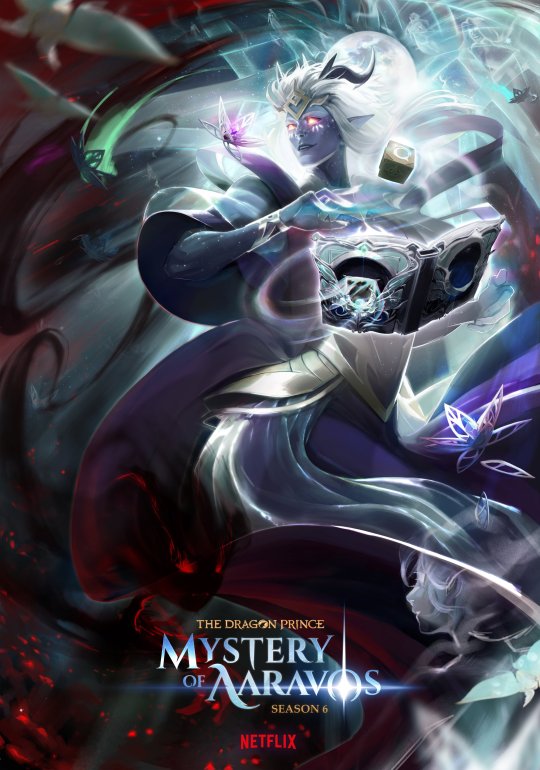
let's see what we've got in this one! omgomgomg
this won't make a lot of sense, I'm just gushing
First impressions: there is a LOT of magic going on in this poster, and most of it seems to be Moon magic, which Aaravos is casting from his cool book.
There are moon moths everywhere!
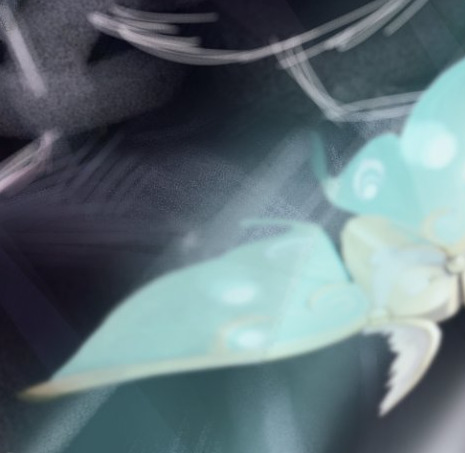

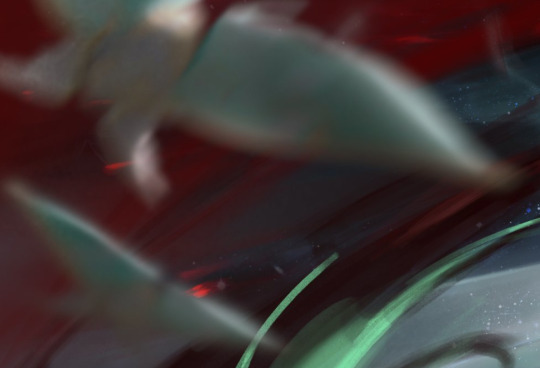
Ethari's lotuses are everywhere too!
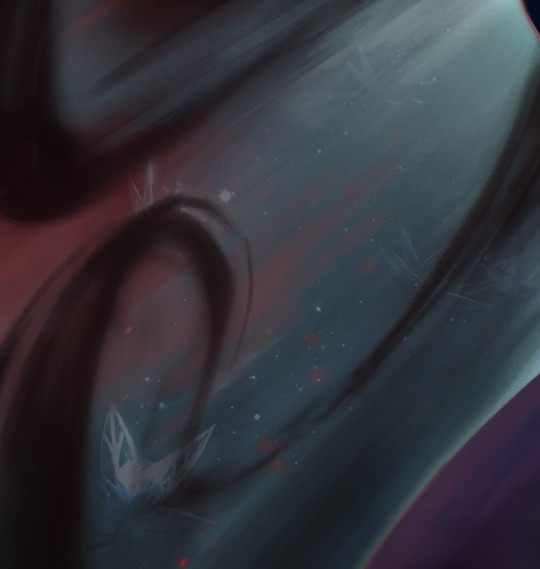
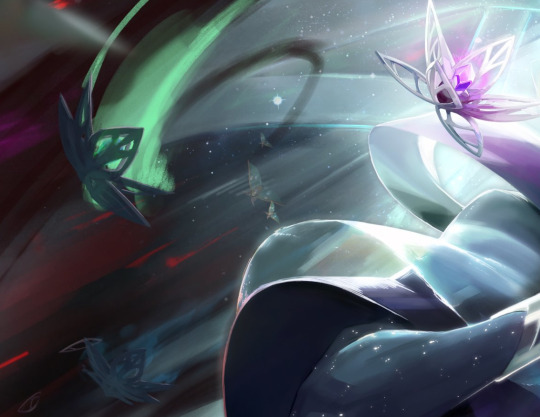
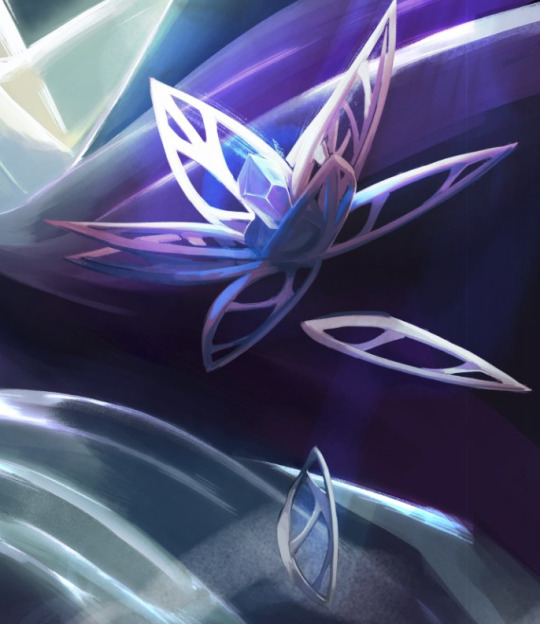
Some of them are breaking. Some of them have vivid colors coming from them. They could be from the differently colored crystals they all have.
There are also a large number of spirits in the picture!
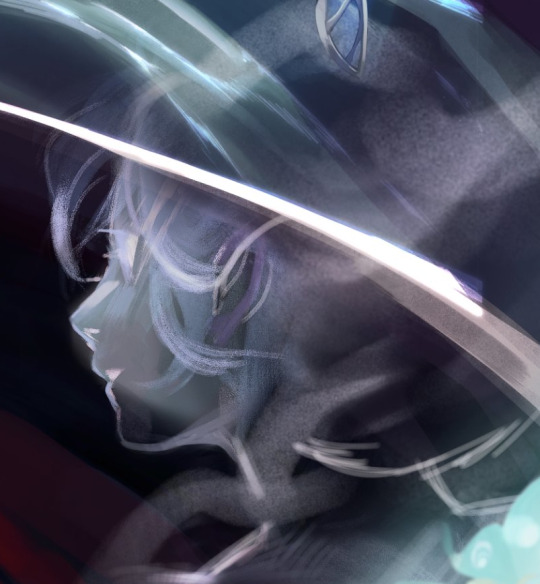
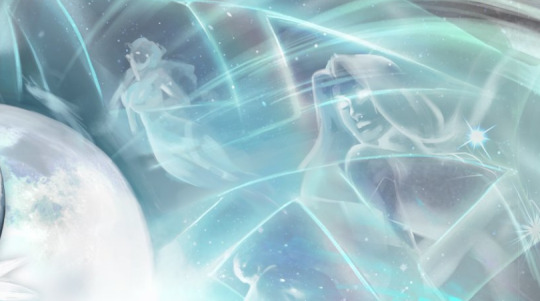

There's also a red colored spirit, uh oh:
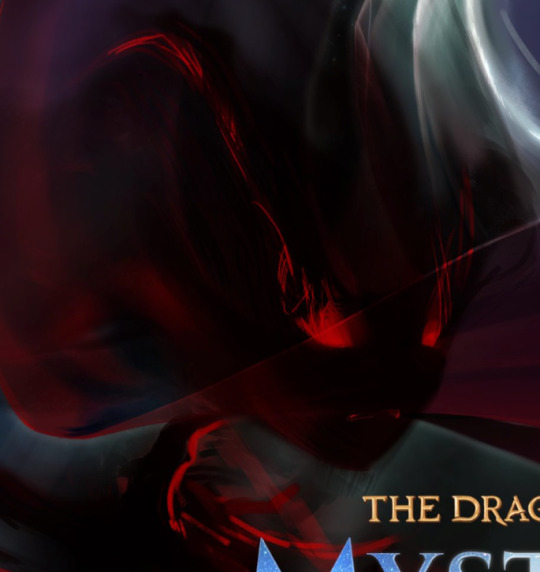
Is this one looking at the white one, do they see each other?
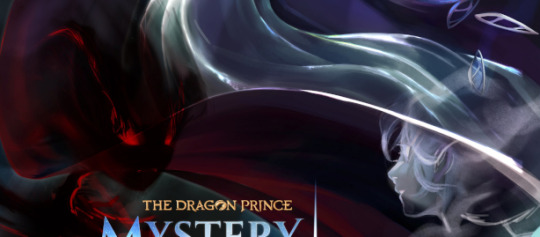
Aaravos has a full moon behind him, and his cube has a blazing moon rune on it. I'm not sure how many other moon themes this poster can hold, are we missing any?
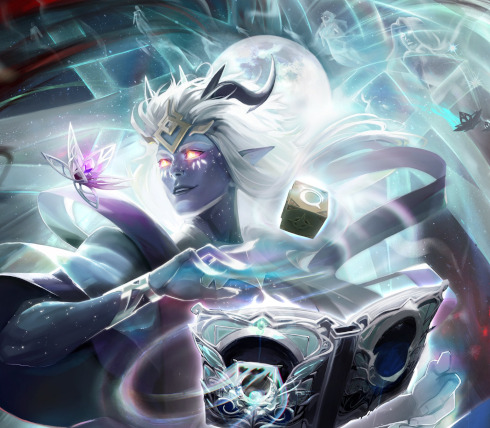
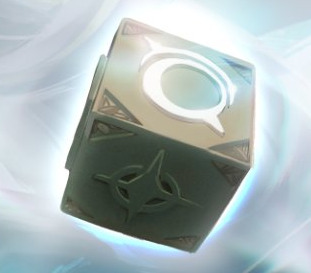
Of interest, there's a thematic similarity to the key art we got of Rayla jumping into the Moon Nexus, where the lower left was dark and creepy with lost spirit arms and the upper right was lighter with the arms of her family reaching for her. In this art, those corners are again the darkest and lightest:
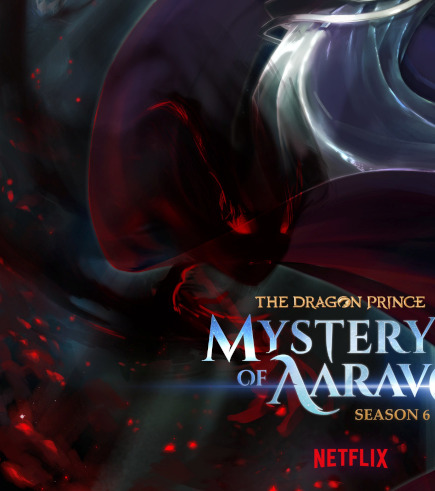

And then there's the man himself. His eyes are glowing bright with magic, he's got his bling on. And it's hard to be certain since we can't see his chest well but it's likely that his star is lit, as it gets when he casts magic.
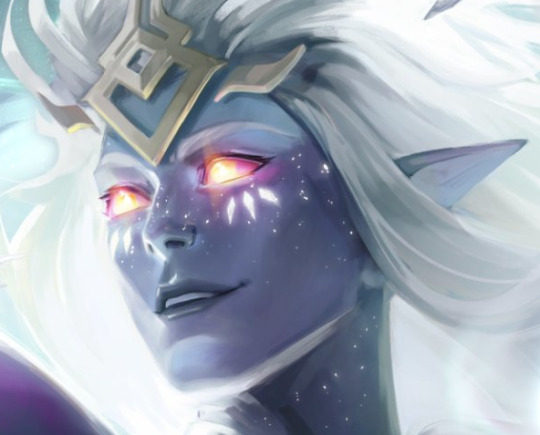
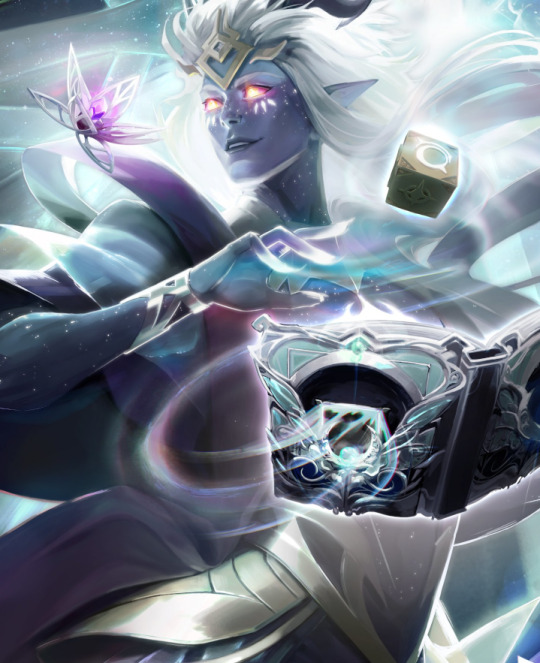
Okay let's take a quick peek at what is actually happening in this poster. Aaravos is casting magic from the book. It's pouring out of the cool crescent-moon portal thingy there and swirling around.
eta: it's actually connecting the rune cube to the book, but I'm not sure which way the connection is flowing. But he seems to have plugged the cube in, and it is called the Key of Aaravos. Is this book the thing of great power that gets unlocked in Xadia?

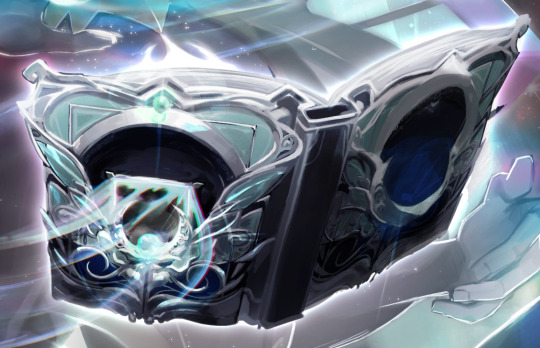
And behind him, across the top of the art, you can see something else: a weaving of thick white strands.
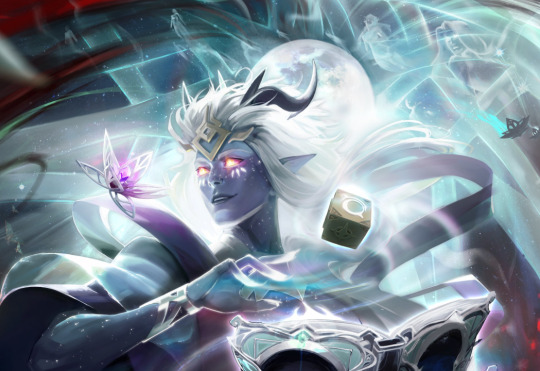
What is he actually doing? Is he weaving them, or unweaving them? Is he just releasing three elves from their coins? This looks way more powerful - and destructive - than that. Is he releasing all the spirits ever? Why are there so many spirits in this picture?? Where are they from? Are they also trapped? Were they crossed over? Is he breaking the whole duality of life and death?
Aaravos wouldn't bother casting a measly little spell just to free three elves from coins just because Callum asks him to, not when he could flex stylishly and get something he also wants out of the deal.
Remember when he helped Viren get past Lux Aurea? He didn't have to kill Khessa and poison the Sunforge to help Viren reach Zym. But his method got the caterpillar a burst of primal magic so it could start growing, it stopped the Sunfire forces from retaliating, it gave him some form of payback on Aditi's bloodline, and it stopped the Sunfire elves from being able to use the Sunforge on anyone else corrupted with dark magic. Plus it netted him Pharos and made Viren trust him even more. It was indeed elegant and efficient.
So he's probably doing something on that level again here. Sure, Callum may have given him an opening to help Rayla's family out. But Aaravos will stop when Aaravos decides to stop, and not before. If Callum makes a deal to free three souls that he can't get out of their coins on his own, then Aaravos can definitely work with that.
But he thinks bigger. If Callum wants three souls freed, that's easy enough. But why stop at three? It's so inefficient. Maybe he attacks the Moon Nexus next, and makes it volcano out all the souls it's ever held and looses them on the world in some kind of spirit plague. Job still done, deal met, requirements satisfied. And while the mortals scramble to deal with his mess, he just does whatever he has planned next. All the better that he did something so big that no one can step away from cleaning it up to try to stop him!
Anyway. Art gives me thoughts. Very excited about this poster and its moontastic implications for S6!
#tdp#tdp spoilers#tdp s6 spoilers#tdp poster#tdp s6 poster#aaravos#moon themes are gonna be very big this season
92 notes
·
View notes
Text

Purpose and Scope
This is a fan-made project explores the spirits of the Fade—their roles, evolution, and duality—as a fair-use reference for fanfiction writers and a resource for the Dragon Age fandom.
It treats all Fade entities as spirits, highlighting demons as corrupted forms, and focuses on canon spirits while incorporating fan-created interpretations. Key topics include their personalities, roles, interactions, and possible corrupted forms.
Note: I do take liberties within the limited scope of information we have and I will do my best to make clear what is canon vs fanon.
Have thoughts, comments, or an idea you'd like me to explore? Ask away!
Updates: Check here.

Introduction to Spirits
- Theory of Spirit Complexity - Questioning the Dichotomy - Spirit Alignments: An Alternative Classification System - When Purpose Falters: An Examination of Spirit Distress and Restoration - Spirit Alchemy: Paths to Purpose
The Nature of Spirits:
- Origins in Chantry Doctrine - Spiritual Abilities - Cultural Views of Spirits

Spirits (Original Purpose)
Chaotic-Based Spirits: These spirits embody breaking norms, disrupting order, and embracing unpredictability. Connection-Based Spirits: These spirits embody emotional connections and acts of care. Learning-Based Spirits: These spirits embody the pursuit of understanding and the thirst for knowledge. Hope-Based Spirits: These spirits focus on uplifting others, fostering belief in better outcomes, and helping others endure hardships. Strength-Based Spirits: These spirits embody moral and physical strength, leadership, and standing firm in one’s convictions. Survival-Based Spirits: Spirits here are driven by primal and instinctual needs—survival, persistence, and raw determination.
Corrupted Spirits (Demons)
Covetous-Based Corrupted Spirits: Spirits corrupted to being driven by fixation, desire, and yearning. Dread-Based Corrupted Spirits: Spirits corrupted to manifesting terror, nightmares, and paralyzing dread. Grief-Based Corrupted Spirits: Spirits corrupted to reflecting loss, regret, and isolation. Vanity-Based Corrupted Spirits: Spirits corrupted to representing pride, envy, and self-centered drives. Wrath-Based Corrupted Spirits: Spirits corrupted to embodying rage, vengeance, and destructive intent.

Spirits (Original Purpose)
Balance-Based Spirits: These spirits counteract chaos, maintain harmony, and focus on long-term balance Chaotic-Based Spirits: These spirits embody breaking norms, disrupting order, and embracing unpredictability. Connection-Based Spirits: These spirits embody emotional connections and acts of care. Learning-Based Spirits: These spirits embody the pursuit of understanding and the thirst for knowledge. Hope-Based Spirits: These spirits focus on uplifting others, fostering belief in better outcomes, and helping others endure hardships. Strength-Based Spirits: These spirits embody moral and physical strength, leadership, and standing firm in one’s convictions. Survival-Based Spirits: Spirits here are driven by primal and instinctual needs—survival, persistence, and raw determination.
Corrupted Spirits (Demons)
(coming soon)

- Notable Spirits (coming soon) - Notable Possessions (coming soon) - Lesser Manifestations: Observing Minor Fade Entities (coming soon)

- Evolution State of Spirits - Emergence from Essence: A Study of Spirit Origins (coming soon) - Balanced Reclaimed: Spirits Who Overcame Corruption - Understanding the Dialect of Spirits - Theoretical Constructs: The Possession Paradox (coming soon) - Origins of Evanuris (coming soon)

This mostly head canon. - Flesh and Fade: The Generation of Elves - Reclaiming the Fragment: The Dormant Spirits of Modern Elves (coming soon)
Acknowledgments: @mythalsknickers
35 notes
·
View notes
Text
clan alerion thoughts, sparknotes edition:
the dalish are highly protective of their dead, and generally a spirit possessing one of them would be seen as a tragedy - it means something has disturbed them, taken them for it's own use. of course when it's not intentionally summoned, a spirit possessing a dead body will usually be or become hostile; this is not the peaceful undead of the necropolis. this is the reason most cultures across thedas practice burning their dead, but for elves the very concept of a physical body was once miraculous, sacred - and while they don't remember why, some of that lives on in their traditions.
the elves of clan alerion follow a different school of thought, one also half remembered from elvhenan. when they found out the titans were waging war on the elves because of their "stolen" bodies, some ancient elves decided against making more of them out of lyrium. instead, they decided the kindest thing to do for the spirits who still wanted their own was to give them theirs upon death. not all spirits who wish for a body can have one, as new spirits are formed all the time and far from all people want theirs to be passed on in such a way, but a few can be given that chance. in a parallel to the nevarran belief that a spirit needs to be called from the fade for the soul of the dead to enter the dead, an elf entering uthenera might allow their body to be used by a different spirit, essentially trading places. the practice was rare to begin with and nearly eradicated during the rule of the tevinter empire, but a small group of practitioners survived in what would later become the nevarran kingdom, where their beliefs influenced and were influenced by those of the humans.
while some of these elves sought out the dalish nation as it was established, others stayed where they were. after the second exalted march, the chantry declared that elves across all of thedas would be given the choice of becoming andrastian and living as second-class citizens under humans, or keep their own faith and be exiled. whatever choice they made, the elves of the dales scattered, as did many of the elves already living with humans.
the alerion clan traces its roots from two sources: dalish elves coming north, and those who left nevarra and surrounding city-states rather than submit to chantry rule. their traditions reflect the duality, especially where it comes to its views on spirits and the dead. when a member of clan alerion dies, their body is stripped of its flesh and cleaned. a spirit is then summoned to inhabit it. great care is taken to ensure it is the right spirit, and that it understands the possession is temporary.
because the clan as ambulatory, letting the spirits stay indefinitely is impossible. they can only have so many following them at a time, and while there is a tomb similar to the var bellanaris, it wouldn't be safe to leave the spirits there unaided. ideally, when someone dies the clan stays for a while in the same spot, mourning but also getting to know their new spirit clan member and letting them adjust to new life. after a while, they move on and the spirit with them. they will travel to the location of their tomb and make a camp there, and it usually doesn't take very long until the spirit feels ready to let the body pass into the tomb, and for itself to return to the fade. the clan has then gone through mourning and come out in the other side, and the spirit has gotten to know all its members and experienced both ordinary clan life and life on the road
the spirit is considered a full member of the clan, and if it wants, other members will call upon it for guidance or company even after it has vacated the body. Every year in autumn, the clan travels to the tomb to invite the spirits to celebrate with them, in or out if the bodies they once inhabited.
13 notes
·
View notes